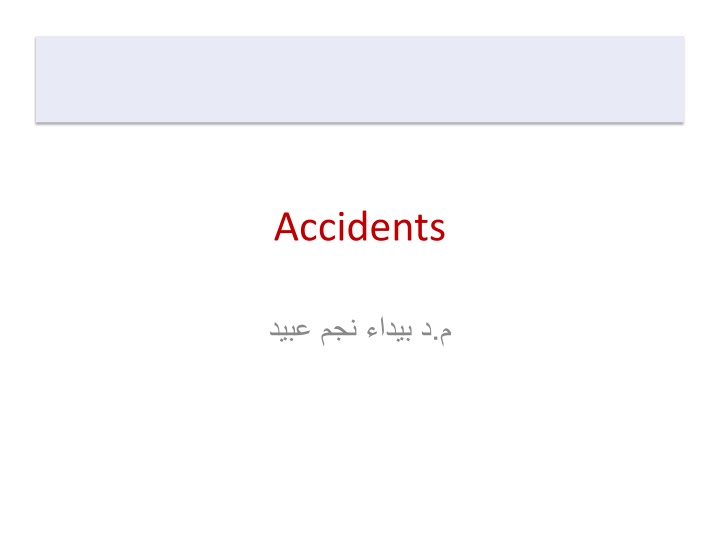
Accidents: Important Facts, Types, and Prevention Measures
Learn about accidents, including their definition, impact on public health, epidemiological patterns, common types such as road traffic accidents and domestic accidents, and prevention strategies like safety education and enforcement of laws.
Download Presentation

Please find below an Image/Link to download the presentation.
The content on the website is provided AS IS for your information and personal use only. It may not be sold, licensed, or shared on other websites without obtaining consent from the author. If you encounter any issues during the download, it is possible that the publisher has removed the file from their server.
You are allowed to download the files provided on this website for personal or commercial use, subject to the condition that they are used lawfully. All files are the property of their respective owners.
The content on the website is provided AS IS for your information and personal use only. It may not be sold, licensed, or shared on other websites without obtaining consent from the author.
E N D
Presentation Transcript
Definition "An unexpected, unplanned occurrence which may involve injury".
WHO definition Unpremeditated event resulting in recognizable damage.
Important facts about accidents * Accidents represent a major epidemic of non-communicable disease. They are no longer considered accidental and they are part of the price we pay for technological progress. * Accidents have their own natural history and follow the same epidemiological pattern as any other disease (Interaction between host, agent and environment). * Accidents occur more frequently in certain age groups, at certain times, and at certain localities. * Certain people are more prone to accidents; alcohol, drugs, physiological and psychological states increase their susceptibility. * The majority of accidents are preventable. * Accidents allover the world, they rank the fourth among the ten leading causes of deaths, leading to 7.5 per cent of deaths in both developed and developing countries. About 4 million of deaths allover the world is due to accidents (only one million is due to intentional injuries).
Types of accidents Road traffic accidents: Accounts for about 1 million of deaths allover the world annually, and for each death, there will be 30-40 minor injuries, and 10-15 serious injuries (disabilities). Mean ages affected are 15-24 years. Domestic accidents: Affects both extreme of ages and the most common causes are; Drowning. Burns. Poisoning. Falls. Injuries from sharp and pointed instruments. Bites and other injuries from animals. Industrial accidents: Thousands workers are died and many others are injured and crippled. Passenger's accidents: Railways, airplanes, ships etc. Burns: 10 per cent of all accidental deaths are due to burns. Wars and Terrorist actions. Causation of accidents: Multiple Human 90 per cent. Environmental 10 per cent.
Prevention of accidents Data collection. Safety education. Promotion of safety measures: Such as safety belts, safety helmets, leather clothing and boots, Children protection and others. Alcohol and other drugs. Primary cares. Elimination of causative agents. Enforcement of laws. Rehabilitation of services: Such as medical, social and occupational. 9. Accidents researches (accidentology).





















